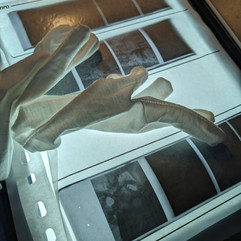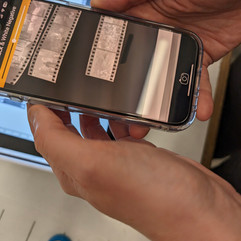We’re thrilled to introduce Clare Williams, an associate artist here at Hazlehurst Studios. In this blog, Clare shares how she joined our creative community and her passion for analogue photography. Discover her journey into traditional darkroom techniques and how Hazlehurst’s darkroom facilities inspire her hands-on approach to art.

Learn more about Clare’s work here, and stay tuned for her unique insights into the beauty of darkroom photography!
Hi, I’m Clare! I joined Hazlehurst as an associate artist around the middle of March 2024 but everyone has been so lovely and welcoming it feels like I have always been here! I was invited by Claire Pitt to come and have a tour around the Studios after attending a Wellbeing Walk around Spike Island back in February. It was then I got talking to Lauren Quayle who was leading the walk alongside representatives from Mersey Gateway Environmental Trust. We actually already knew of each other via Instagram, but had never met in person or even really interacted. So it was a happy coincidence then, that my husband had booked us both onto this particular walk after seeing it advertised online.
During the walk, Lauren noticed I was using a couple of analogue film cameras and had greatly enthused about the new darkroom and film development facilities which were being fitted at Hazlehurst. By the end of the walk she had invited me to come and have a brew and a proper look around the building. The following week Lauren had introduced me to Claire via email who then invited me in for a look around. While there I was also very interested to learn there were some creative hotdesking and associate opportunities available and was keen to get involved ASAP.
After attending a darkroom and film development refresher induction with Nick Carrillo, I was then free to come and use the darkroom and developing equipment as often as I like. So, let me take you on a tour of the facilities we have here!
There are plenty of different sized developing tanks and reels, changing bags, chemicals, a timer and anything else you might need to develop your black & White films. C41 Colour film development is something else we are looking at supporting in the near future, very exciting news indeed!

Once our film is developed there is a cabinet for drying the negative strips, this takes but 20 minutes. This is a big improvement on the 3 hours plus I would impatiently wait at home previously, all while worrying I’d knock the strips and potentially damage the negatives. This drying cabinet was donated to us by a local college, along with lots of other photography equipment.

We have a lightbox available to use to view your negatives and choose which ones you will print. In the photos below, Lauren is using an app on her phone to convert the negative images to positive to give her an idea how they have turned out before scanning or darkroom printing.
The darkroom itself is fairly compact but functional, housing two colour 35mm enlargers and a wet area for the chemical trays. We are intending to have a 120 negative enlarger setup in the future. I will be diving straight in to print from my backlog of 120 film negatives when it’s all set up.
After printing and rinsing there are drying racks available to use, keeping your precious prints separated while they dry and avoiding watermarks.

I am very much enjoying being able go and shoot a film in the morning and then come into Hazlehurst to develop and print photos in the afternoon.
I also love shooting with colour film and experimenting with different film emulsions, but at the moment that means sending them to a photo lab to process. There is obviously always a risk with this and I, like most analogue photographers, get very anxious that my film will get lost or damaged in the post and the extra time waiting for the post to get my photos back.
When we have colour processing facilities, a whole world of experimentation and possibilities will open up, including being able to make ‘Film Soup’! This involves soaking a film roll in different “soup recipes”, basically a mixture of household ingredients and chemicals such as lemon juice, washing up liquid and salt. The roll is left to soak in this liquid for a few weeks and then thoroughly dried out in its cannister before developing as normal. The chemicals affect the film emulsion, creating some interesting and psychedelic visual effects and colour shifts. Souping is not something I have tried so far, but I am very keen to experiment.
Also coming soon to Hazlehurst, we will be setting up our very own photography studio, complete with studio lights and backdrops. Perfect for portrait and still life shooting sessions.
If you would like to come and try the facilities out for yourself, we have regular darkroom and developing workshops available to book onto. Keep an eye on Eventbrite to book onto those or get in touch if you are interested.
November Update: Since I initially wrote this post, Nick and I have launched the Hazlehurst Analog Photo Collective! Based here at Hazlehurst Studios in Runcorn, this new collective is dedicated to exploring analog photography in all its forms. We welcome photographers, lens-based artists, and anyone interested in experimenting with film.
The collective meets on the third Thursday of each month from 18:00 to 20:00, starting with our next session on Thursday, 21st November 2024. We have access to a variety of analog equipment—including cameras, film processing tanks, a small darkroom, and studio lighting—making it the ideal space to develop your skills, exchange ideas, and celebrate the art of film photography together.
If you're interested in joining us, please reach out—we’re excited to see where this new community will take us!
The next post from Clare will be about the Big Film Photowalk we took part in back in June
























Clare Williams' insights on Hazlehurst Studios' darkroom facilities are fascinating! It’s great to see the dedication to preserving analogue techniques. On a related note, for anyone into creative work, I’ve been using how to record a webinar on computer to capture and share digital projects. It’s really intuitive and produces high-quality recordings, whether for tutorials or personal projects. Definitely worth checking out if you need a reliable tool!